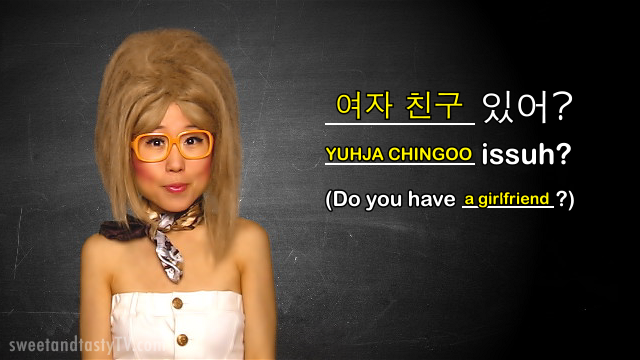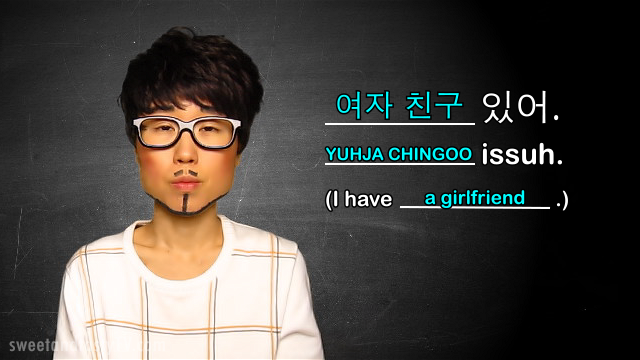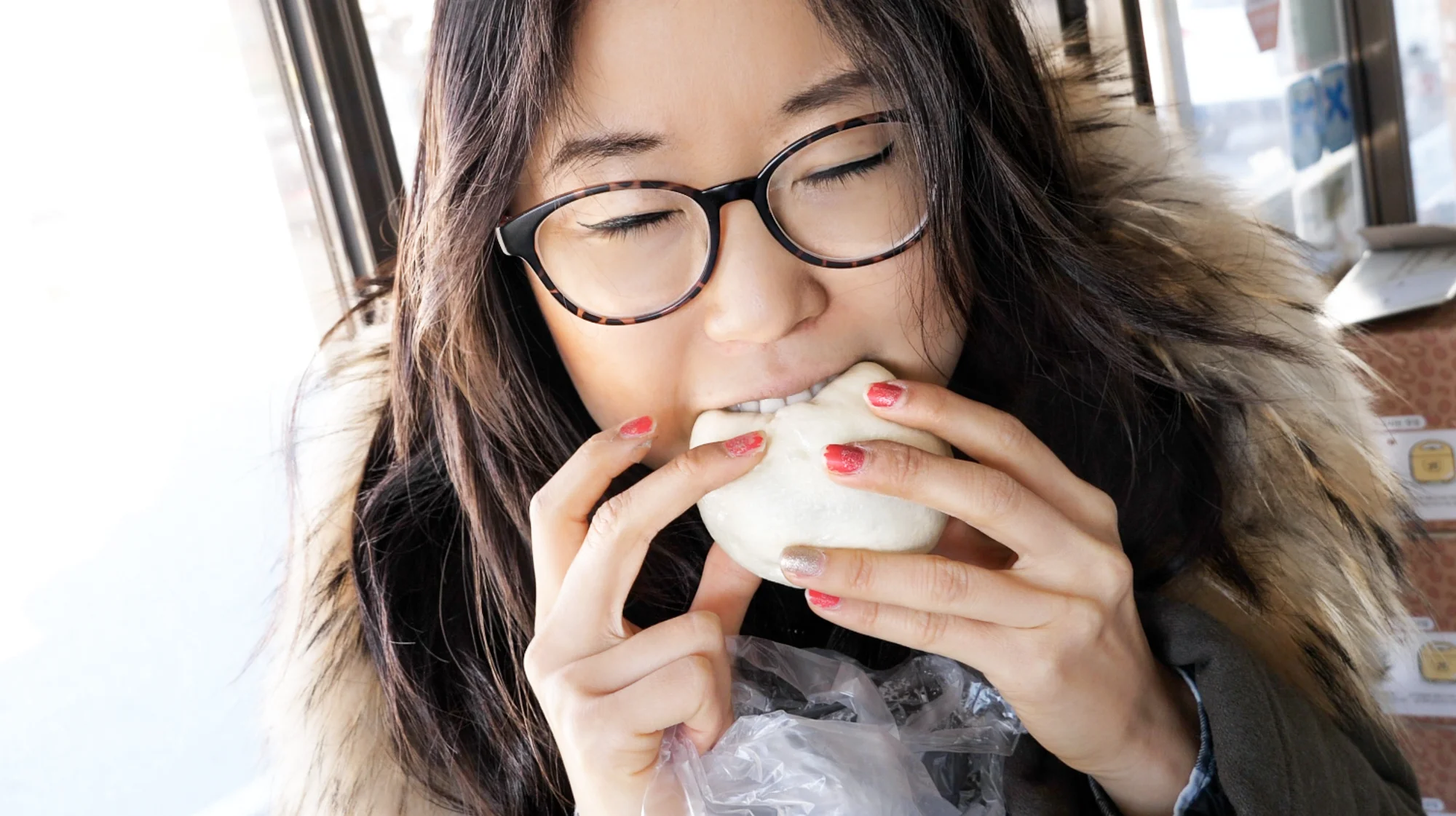This week on KWOW episode 56, we learned about Korean cuisine. Food is an extensive topic, so we're specifically focusing on common terms that will help you read the Korean menu. You'll understand the difference between rice and noodles:
Let's do a review of the featured terms. I hope your eyes are hungry because they are about to see mega digital calories! If the following photos make you too hungry, scroll down quickly and enter the weekly contest! :)
Rice is BAP (밥) in Korean. Bap is also the general term for "food." Here are some popular bap dishes:
1. HUINBAP (흰밥) is cooked white rice. Many Korean households eat huinbap on a daily basis, three meals a day. Note: HUIN (흰) means "white."
2. OGOKBAP (오곡밥) is the delicious "five grains rice." It is a more nutritious substitute for white rice. Despite the name, you can add as many grains as you like, including black bean, red bean, foxtail millet, and barley.
3. GIMBAP (김밥) literally means "seaweed rice." Gimbap may look like sushi, but take a closer look. They are similar yet different. Gimbap does not contain raw fish. Gimbap is typically filled with vegetables, eggs, and meat. (Also Romanized as "kimbap.")
4. BIBIMBAP (비빔밥) literally means "mixed rice." It contains a variety of vegetables placed on top of white rice, along with a spoonful of red pepper paste. Add an egg and some meat. Stir the ingredients and enjoy!
Trivia: Sometimes Korean people joke around and call the K-pop boy band B.A.P. as "bap."
Maybe it's cold outside and you want to warm yourself up. Look for 찌개 (JJIGAE), which is "stew." The jjigae dish contains tofu, meat or seafood, scallions and other vegetables. Be Korean and order your stew extra spicy!
5. KIMCHI JJIGAE (김치 찌개) is kimchi stew. It is one of the more popular stews.
6. SOONDUBU JJIGAE (순두부 찌개) is soft tofu stew. While most jjigae variations contain a couple pieces of tofu, the soondubu jjigae contains A LOT of tofu.
7. DWENJANG JJIGAE (된장 찌개) is the delicious "soybean paste stew." It may be an acquired taste for some, but for those who grew up eating it, this dish is heaven. Tastes cozy!
8. BUDAE JJIGAE (부대 찌개) was a dish born after the Korean War. It's called the "army stew" because it uses Spam, Frank sausages, and sliced American cheese. All the ingredients that were present around U.S. Army bases in Korea.
While reading the menu, you may come across this curious character: 탕. What can the capitalized E, half H, and circle possibly mean? 탕 means "soup" and is pronounced as TANG.
9. SEOLLUNGTANG (설렁탕) is the tasty "ox bone soup." The bones are boiled until the stock becomes a milky-white color. Sprinkle some salt, pepper and scallions to flavor it up another notch. Eat it with your white rice (huinbap).
10. SAMGYETANG (삼계탕) is yet another scrumptious dish. Translated as "ginseng chicken soup" in English, it is particularly enjoyed during those hot summer months.
11. GALBITANG (갈비탕) is short ribs soup. Unless you are an experienced cook, we recommend you eat this at a restaurant because it can take over five hours to make!
Another word for "soup" is GOOK (국).
12. DDUKGOOK (떡국) is the annually eaten "rice cake soup." Koreans enjoy it on the Lunar New Year with their families.
13. MIYEOKGOOK (미역국) literally means "seaweed soup" and is indulged on birthdays.
14. KONGNAMULGOOK (콩나물국) literally means "soybean sprout soup" and is known to reduce hangovers.
Whether it's winter or summer, 면 (MYUN) can be enjoyed all-year round. Myun is the Korean word for "noodles."
15. JJAJANGMYUN (짜장면) is the yummy "blackbean noodles." Have a napkin ready and wear non-white clothes. As delicious as this dish is, things can get real messy if you don't know how to use your chopsticks!
16. NENGMYUN (냉면) are cold noodles. These handmade noodles served in iced broth are a great way to cool down during those hot summer days.
17. RAMYUN (라면) are what we in America call "instant noodles." In Japan, they're called "ramen." Every culture has their own unique way of cooking up these noodles. Koreans love adding kimchi and scallions into theirs. Not such a surprise considering that Koreans use kimchi for pretty much everything!
While GOOK means "soup"... GOOKSU means "noodles."
18. KALGOOKSU (칼국수) means "knife noodles" in Korean. It sounds a bit ominous, but the name refers to the fresh handmade, knife-cut noodles (as opposed to being stretched or spun).
19. KONGGOOKSU (콩국수) are "soymilk noodles" served cold with floating ice cubes. The noodles are made up wheat flour and topped off with a small handful of raw veggies.
20. MAKGOOKSU (막국수) are "buckwheat noodles" also coolly-served. Similar to nengmyun, except buckwheat noodles contain more buckwheat flour.
Are you eating out with your buddies? 전 (JEON) is a great family-style dish! Jeon are Korean pancakes. Unlike the sweet, breakfast pancakes in America, jeon are savory pancakes.
21. KIMCHIJEON (김치전) is the delicious "kimchi pancake." There's not much to say about it but the fact that it is delightful.
22. PAJEON (파전) is perfect for green onion lovers. Pajeon means "scallion pancake" in English.
23. SAENGSEONJEON (생선전) literally means "fish pancake." If you love fish, you're going to love this one.
24. GAMJAJEON (감자전) seems to be the easiest pancake for shy foreigners. After all it's just a "potato pancake." Who doesn't like potatoes?
JOOK (죽) means "porridge" in Korean. Because of its soft texture, jook is typically eaten when you're sick and is particularly popular among the elders.
25. DAKJOOK (닭죽) is delicious whether or not you are sick and elderly. 닭 (DAK) means "chicken," thus 닭죽 (DAKJOOK) means "chicken porridge."
26. JEONBOKJOOK (전복죽) means "abalone porridge." It's a local delicacy on Jeju Island.
27. PATJOOK (팥죽) is a "red bean soup" can be made sweet or savory. In other words, it can be eaten during dinner or for dessert.
28. HOBAKJOOK (호박죽) literally means "squash porridge." The floating rice cake balls make this porridge so cute!
Another common Korean food word is BOKKEUM (볶음), which means "stir-fried." Enjoy these dishes with your white rice (huinbap).
29. BOKKEUMBAP (볶음밥) means "fried rice." While there are many varieties of bokkeumbap, the most famous kind is kimchi bokkeumbap. (Read #33.)
30. MYEOLCHI BOKKEUM (멸치볶음) is a classic Korean side dish: stir-fried anchovies.
31. OJINGEOCHAE BOKKEUM (오징어채볶음) can be a fun little challenge for foreigners: stir-fried dried squid strips. The dried squid strips can also be enjoyed without the additional seasoning.
32. NAKJI BOKKEUM (낙지볶음) is stir-fried octopus. The dish is created with cabbage, onions, scallions, and more.
KIMCHI (김치) is Korea's most popular side dish. To learn more about kimchi, watch KWOW episode 22. Then impress your Korean neighbor with your new knowledge!
33. KIMCHI-BOKKEUM-BAP (김치 볶음밥) is a combination of three common food terms we learned today. Can you guess what it means in English? That's right, it's kimchi fried rice!
34. KIMCHIJJIGAE (see #5) 35. KIMCHIJEON (see #21)
Wow, I feel like I just ate a 35-course meal just by looking at all these food photos! The featured dishes are only a portion of Korean cuisine. We focused on teaching you the common words to build your food foundation.
If you haven't yet, catch up on these yummy episodes:
KWOW #26 - Korean sidedishes (banchan)
KWOW #30 - Korean desserts
KOREAN TABLE MANNER:
Before a meal, Koreans will politely say "잘 먹겠습니다" (Jal muckgesseubnida), which in literal translation means "I will eat well." This phrase is formal, so use it towards towards those older than you. Say "잘 먹겠습니다" to the cook--your mother or the host--or to the one buying you food. When you've finished the meal say, "잘 먹었습니다" (Jal mukeossubnida). "I have eaten well." Regardless of meal's taste, it is well-mannered to show your appreciation.
The informal version of the above phrases are:
"잘 먹을께." / Jal mukeulggeh. / I will eat well.
"잘 먹었어." / Jal mukeossuh. / I have eaten well.
KWOW CONTEST OF THE WEEK:
1. Write the phrase ten times on a paper: 잘 먹겠습니다.
2. Then write this second phrase also ten times: 잘 먹었습니다.
3. Take a photo of your beautiful work.
4. Upload the photo onto Twitter.
5. Copy and paste the link in the comment section below. (Note: Other submissions may not be considered an entry.)
6. Don't forget to ask your fun/crazy/yummy question to this week's KWOW host Taekwon Do.
7. Have fun! The first *five people* to complete the task will win a reply from Taekwon Do :)




















































